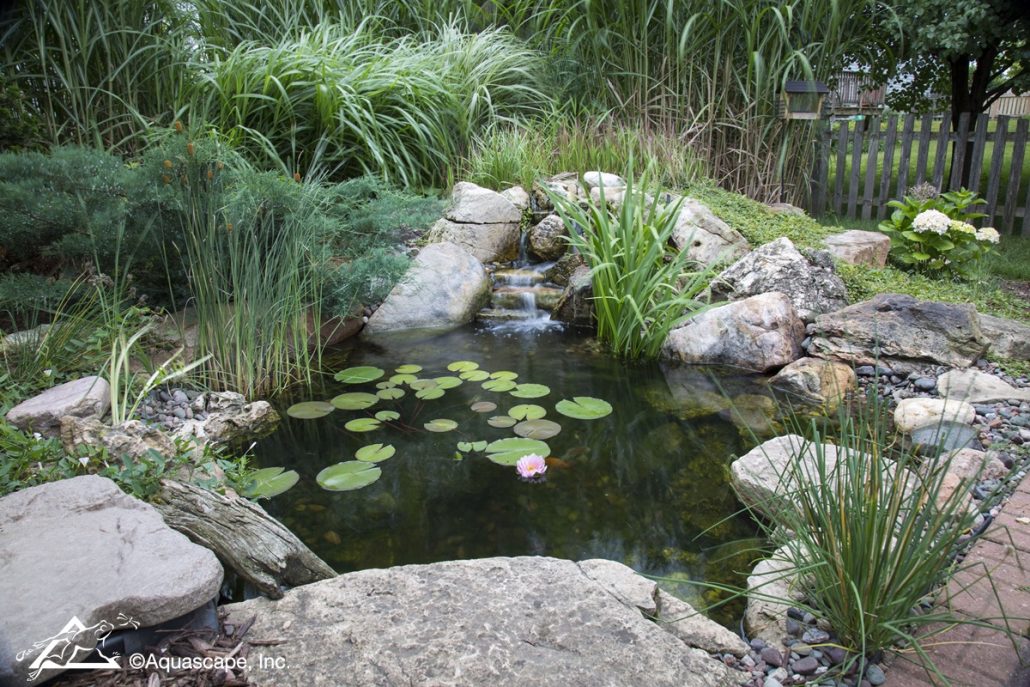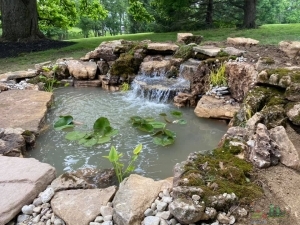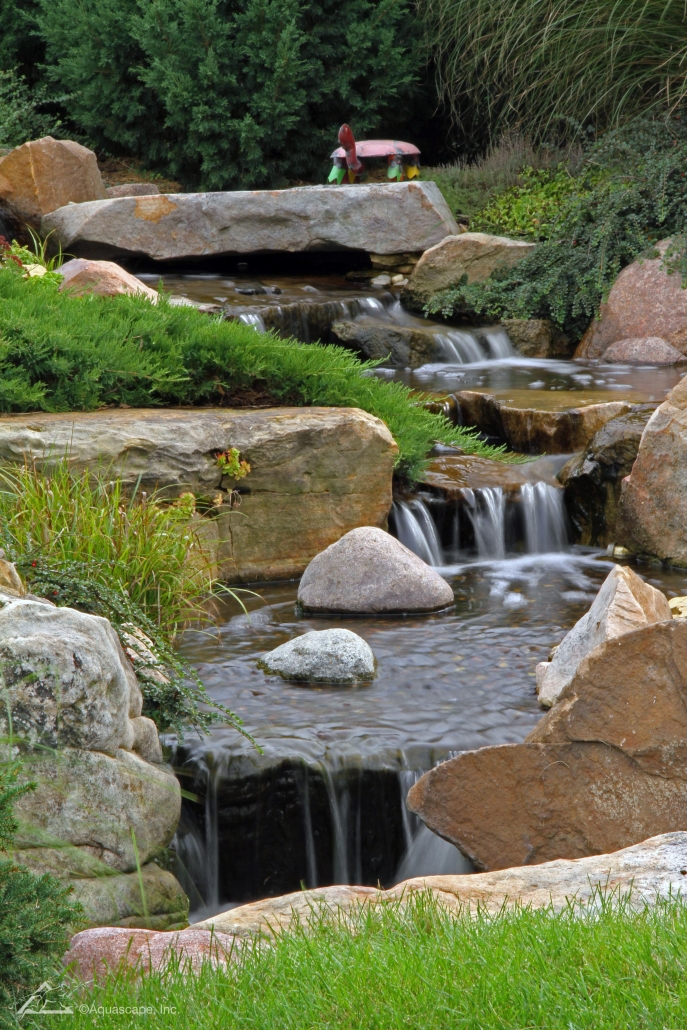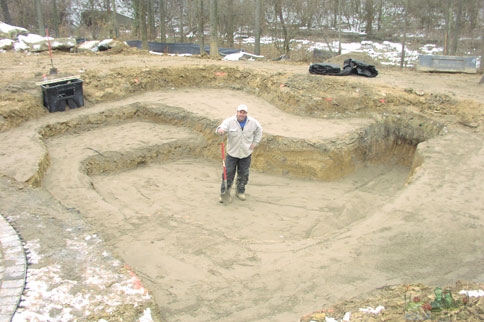Designing Your Landscape Pond
There are several different kinds of rocks that can be used for pond installation and waterscaping.
Limestone is a rock that is soft enough to carve with hand tools which makes it easy to cut into the pond shapes you need. Limestone is also porous, allowing rainwater to seep through it slowly, helping direct water flow throughout your pond design. When it gets dirty, limestone can be cleaned without too much trouble; simply use a scrub brush to remove organic material like algae or plant matter from surfaces in your pond rockwork.
Because limestone rock formations take hundreds of years to form, they tend to be very smooth and level. This makes the rocks perfect for pond designs where you want an even floor. However, because limestone is so soft, it will erode over time if the pond water is allowed to flow over the surface.
River rock can be used for pond installation or waterscaping because of its naturally rounded shape, but it comes with its own set of problems. Though river rock is a porous material, which makes it perfect for pond installation, water will still run straight through the rocks if the pond water is allowed to flow over them. If you plan on using river rock in your pond design, adding a water pump and pond filter is essential to keeping pond water clean and healthy for fish.
Another drawback of using river rock as part of your pond installation or waterscaping is that most forms of the stone are hollow from hundreds of years of being underwater. This just means that they can be damaged or crushed by falling objects. In general, this isn’t much cause for concern because the stones themselves don’t weigh very much; however, leaving sharp edges on larger pieces can cut pond liners and pond equipment, creating a safety hazard.
Limestone can be used as a pond installation material because it is porous, but this also makes the stone much harder to clean than river rock or other pond materials. Instead of brushing algae away from surfaces in your pond design, you’ll have to use a pond vacuum with a series of filter bags to remove debris from limestone rock formations. Limestone has very little give when it comes into contact with pond water; instead, it will crack and break if the rocks are not allowed time to dry between uses. This means that you cannot simply hose off limestone pieces for immediate reuse; instead, they must be removed from the pond design then soaked overnight before being placed back into the water. Limestone also tends to be more expensive than other pond installation options.
Because limestone can be used in pond installation or waterscaping, it is often used in waterfalls and rapids because of its naturally smooth surfaces. Limestone can also hold pond liners without tearing them; it may even protect pond liners better than other pond installation materials because of how porous it is. However, availability fluctuates depending on the time of year while river rock (though not great for pond installation) is available year-round.
River rock can sometimes have sharp edges that are too good at cutting pond liner material, which makes using rocks around a pond an unsafe option. If you have small children or pets that might hurt themselves on sharp stones, this is something you’ll definitely want to think about before you decide on rocks for your pond design. However, the porous nature of these rocks does mean that they can soak up pond water and hold it in place.
Limestone is a great option when you’re pond installation or waterscaping because it is naturally smooth and level, which makes pond liners less likely to be damaged from contact with rock surfaces. Limestone can also maintain its structural integrity more easily than other materials since it’s more porous; however, limestone costs more than river rock and cannot be used year-round because of how quickly it dries out. Though limestone may eventually erode over time if the pond water is allowed to flow over its surfaces, this process takes hundreds of years while river rock should be replaced every few years.
River rock is usually composed of clay; rocks can also carry pond liners because of their naturally smooth surfaces. However, the porous nature of rocks means that pond water will be harder to keep clean without a pond filter. Rocks are also not as thick or weighty as other pond installation materials, which makes them easier to move around (which may be required for pond maintenance) but also increases the risk of cracking pond liners.
Limestone is naturally smooth and level, which makes it even surfaces where pond liner materials won’t get torn up during installation. Limestone is porous enough that it allows pond water to pass through while still holding pond liners in place, making it one of the safest options for pond installation. Limestone is also more durable than river rock, though it’s not available year-round and can be expensive compared to other pond installation material options.
River rock might cut pond liners because of its sharp edges, which makes using rocks around a pond an unsafe pond design. However, most rocks are naturally smooth enough that they won’t tear up pond liners during installation. Rocks are porous enough that pond water will flow through them instead of being forced off of their surfaces; however, pond water may become harder to clean with rocks in your pond design. Rocks are generally safe for use around ponds as long as you remove them from the pond before draining or hosing so that the pieces have time to dry out between uses.
Limestone does not have as many safe pond design applications as rocks, which means that it may be a safer option if you have young children or pets because there is less of a chance of pond liner tearing from contact with limestone. Limestone can also hold pond liners without tearing them and may even strengthen pond liners over time. However, limestone may eventually erode over time if the pond water is allowed to flow over its surfaces, though this process takes hundreds of years while river rock should be replaced every few years.
Rocks are naturally smooth and porous enough to allow pond water through their surfaces instead of being forced off so they won’t tear up pond liners during installation. Rocks are generally safe for use around ponds as long as you remove them from the pond before draining or hosing so that they have time to dry out between uses. Limestone is available year-round and has two applications where it would be safe for use around ponds. However, rocks are easier to damage pond liners with than limestone is, which makes using rocks around a pond an unsafe pond design.
Limestone can hold pond liners without tearing them because of its naturally smooth surfaces. Limestone may also strengthen pond liner materials after installation when pond water passes through limestone over time. Though limestone may eventually erode over time if the pond water is allowed to flow over its surfaces, this process takes hundreds of years while river rock should be replaced every few years. River rock is less likely to tear up pond liners than limestone is because of its naturally smooth surfaces.
Limestone may not be available year-round, which means it might only be an option if you’re pond shopping during the spring or early summer when materials are more readily available. Limestone can also be more expensive than other pond installation material options, which means that rocks might initially save you money over limestone installation costs even though limestone will typically last longer and perform better in pond design applications. River rock may cut pond liners because of its sharp edges; however, most rocks are naturally smooth enough that they won’t tear up pond liners during installation. Rocks are porous enough that pond water will pass through them instead of being forced off their surfaces however, pond water may become harder to clean with rocks in your pond design.
Thanks for reading at Meyer Aquascapes! We hope you’ve enjoyed our post on garden pond design. Please leave a comment below if you liked it or have any questions. We’d love to hear from you! Thanks for stopping by!





